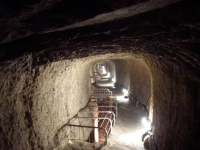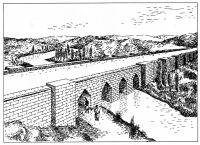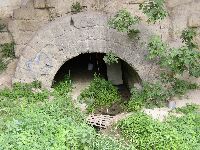


| Late history |
Early history of the aqueducts
The Romans were not the first people channel water long distances. The Assyrians developed the technique of tunnelling that is still used today in the Iranian plateau to supply modern Tehran with water. These tunnels, named qanats, tap underground aquifers and drain the water out to the side of a hill. They are usually about 1.5 metres wide and 3 metres tall. The Assyrian ruler Sargon II spread the technique of building qanats in the 8th century BC. His engineers may have learned the techniques when they visited northern Iran and western Turkey during military campaigns. The qanat supplied the cities of the Medes and Persians with water, and then spread throughout space and time to be used in north Africa, Spain and even the Americas to this day. Two of the Roman aqueducts, the Appia and Virgo, bear a resemblance to to qanat construction: they tap underground water sources and lead the water to to a hillside exit by means of a tunnel. These Roman aqueducts had their model in the Etruscan techniques of drainage, such as can be found in the valleys near Veii.Nineveh
A different system supplied Assyrian Nineveh. Three construction projects re-routed water from a tributary of the Tigris, using dams and broad open-air canals. The last and most elaborate of these projects channelled water into a reservoir made by damming a gorge of the Atrush river, approximately 55 kilometres from Nineveh. From this dam an older canal carried the water to the Khosr river, where the water was again dammed and routed by another canal to the city. A notable achievement of this early 7th century project is the Jerwan aqueduct bridge, which crossed a valley between the Atrush river dam and the Khosr. Made from stone, it still exists and measures 300 metres long and 12 metres wide.The Greeks
The Greeks supplied many of their towns with aqueducts before Roman occupation. The typical Greek technique was to channel water through pipes laid in a secondary channel. Herodotus describes an engineering feat on the island of Samos (3.60):"... a tunnel nearly a mile long, eight feet wide and eight feet high, driven clean through the base of a hill nine hundred feet in height. The whole length of it carries a second cutting thirty feet deep and three feet broad, along which water from an abundant source is led through pipes into the town".Classical Athens had several aqueducts. One drew water from Mt. Pentelicus and had to pass through a hill outside of Athens by means of a tunnel. In the early 2nd century BC, Pergamum acquired an aqueduct 42 kilometres long. This consisted of two, and in places three, parallel subterranean terracotta pipes. This was one of the high points of Hellenistic engineering, and included a section under pressure that enabled the pipes to cross two valleys at elevations below that of the water's terminus in the town (Aicher, 1995:2).
Etruscans
The modern consensus is that the Etruscans had developed techniques of land-drainage and water-supply which involved tunnelling through the soft volcanic rock of the region. )1 The most common form was the cuniculus (plural: cuniculi), which could take any form from trench to a complex system of tunnels. The uses were irrigation, drainage, diversion and supply. The Romans used the cuniculi of Veii to mine into the citadel.|
The cuniculi found in the volcanic tufo in and around Rome (similar to the qanats of Iran) were excavated by the Etruscans mainly for the collection of drinking water,
and, secondly, in some cases, for drainage and irrigation purposes. Today most cuniculi have dried up; a few still collect a small amount of water. However, in Etruscan
times the climate was wetter. Cuniculi are evidence of the high level of civilization achieved by the rural population of that time. For details, see the website of Franco Ravelli and Paula J. Howarth. |
The Etruscan kings are also credited with Rome's first notable hydraulic work. During the reign of Tarquinius Priscus in the 6th century BC, the low-lying areas of Rome were drained by means of a system of canals. The main canal, running from the Subura through the area that was to become the forum, was named the Cloaca Maxima (Torelli, in Rosenstein & Morstein-Marx, 2006:81). It collected water from a large number of feeder drains, and was vaulted over in the 2nd century BC. It still carries run-off water into the Tiber today. The mouth of the tunnel is visible in the left bank of the river downstream of the Tiber Island and south of Ponte Palatino. Rome's sewer system was the hidden half of Rome's water system. Strabo ('Geography', 5.3) and Cassiodorus (7.6) state they were equally as impressive as the roads and aqueducts. It was only through Tarquinius Priscus' construction efforts that the valley between the Capitoline and Palatine Hills was rendered dry enough to construct the forum. This area, though insignificant at first, grew into the financial and political centre of Rome, and subsequently of the Roman Empire.
The Romans
The earliest aqueducts of Rome were constructed in a manner similar to the drainage channels built by the Etruscans. The aqueducts evolved over time, becoming more complex and specialised, with the Romans benefiting from the experience of those that came before them. Roman economy and society, the system of patronage and love of baths, encouraged the undertaking of large civic projects. Distant and secure borders made this possible. It is unlikely that the censor Appius Claudius Caecus would have been able to build either the Appian Way or the Aqua Appia had it not been for Rome's military successes in the preceding two centuries. Building roads and aqueducts requires some measure of stability, or at least the ability to enforce and maintain law and order over some area. The outcome of the Latin, Samnite and Etruscan wars in a sense paved the way for Rome's civil expansion into Italy, the local control and stability allowing the Romans to improve their city, and this in turn feeding back and allowing them to extend their reach, which in turn lead to the development of stabilising infrastructure. During the period preceding and during the construction of the first aqueduct, the Appia, Rome fought a remarkable series of battles. The fact that the Romans were capable of this series of battles while transforming their civil practices speaks of their vigour at this time. A list of the most important battles follows (Flower, 2004:24):327-326: Neapolis
326-304: The Samnites
312-298: The Marsi and other tribes of cental Abruzzo
311-308: The Etruscans
310-308: The Umbrians
From the thesis of Evan J. Dembskey on The aqueducts of Ancient Rome